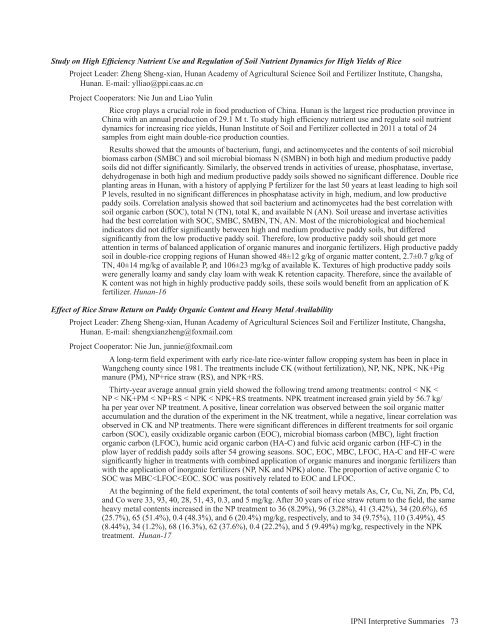Americas and Oceania Group - International Plant Nutrition Institute
Americas and Oceania Group - International Plant Nutrition Institute
Americas and Oceania Group - International Plant Nutrition Institute
Create successful ePaper yourself
Turn your PDF publications into a flip-book with our unique Google optimized e-Paper software.
Study on High Efficiency Nutrient Use <strong>and</strong> Regulation of Soil Nutrient Dynamics for High Yields of Rice<br />
Project Leader: Zheng Sheng-xian, Hunan Academy of Agricultural Science Soil <strong>and</strong> Fertilizer <strong>Institute</strong>, Changsha,<br />
Hunan. E-mail: ylliao@ppi.caas.ac.cn<br />
Project Cooperators: Nie Jun <strong>and</strong> Liao Yulin<br />
Rice crop plays a crucial role in food production of China. Hunan is the largest rice production province in<br />
China with an annual production of 29.1 M t. To study high efficiency nutrient use <strong>and</strong> regulate soil nutrient<br />
dynamics for increasing rice yields, Hunan <strong>Institute</strong> of Soil <strong>and</strong> Fertilizer collected in 2011 a total of 24<br />
samples from eight main double-rice production counties.<br />
Results showed that the amounts of bacterium, fungi, <strong>and</strong> actinomycetes <strong>and</strong> the contents of soil microbial<br />
biomass carbon (SMBC) <strong>and</strong> soil microbial biomass N (SMBN) in both high <strong>and</strong> medium productive paddy<br />
soils did not differ significantly. Similarly, the observed trends in activities of urease, phosphatase, invertase,<br />
dehydrogenase in both high <strong>and</strong> medium productive paddy soils showed no significant difference. Double rice<br />
planting areas in Hunan, with a history of applying P fertilizer for the last 50 years at least leading to high soil<br />
P levels, resulted in no significant differences in phosphatase activity in high, medium, <strong>and</strong> low productive<br />
paddy soils. Correlation analysis showed that soil bacterium <strong>and</strong> actinomycetes had the best correlation with<br />
soil organic carbon (SOC), total N (TN), total K, <strong>and</strong> available N (AN). Soil urease <strong>and</strong> invertase activities<br />
had the best correlation with SOC, SMBC, SMBN, TN, AN. Most of the microbiological <strong>and</strong> biochemical<br />
indicators did not differ significantly between high <strong>and</strong> medium productive paddy soils, but differed<br />
significantly from the low productive paddy soil. Therefore, low productive paddy soil should get more<br />
attention in terms of balanced application of organic manures <strong>and</strong> inorganic fertilizers. High productive paddy<br />
soil in double-rice cropping regions of Hunan showed 48±12 g/kg of organic matter content, 2.7±0.7 g/kg of<br />
TN, 40±14 mg/kg of available P, <strong>and</strong> 106±23 mg/kg of available K. Textures of high productive paddy soils<br />
were generally loamy <strong>and</strong> s<strong>and</strong>y clay loam with weak K retention capacity. Therefore, since the available of<br />
K content was not high in highly productive paddy soils, these soils would benefit from an application of K<br />
fertilizer. Hunan-16<br />
Effect of Rice Straw Return on Paddy Organic Content <strong>and</strong> Heavy Metal Availability<br />
Project Leader: Zheng Sheng-xian, Hunan Academy of Agricultural Sciences Soil <strong>and</strong> Fertilizer <strong>Institute</strong>, Changsha,<br />
Hunan. E-mail: shengxianzheng@foxmail.com<br />
Project Cooperator: Nie Jun, junnie@foxmail.com<br />
A long-term field experiment with early rice-late rice-winter fallow cropping system has been in place in<br />
Wangcheng county since 1981. The treatments include CK (without fertilization), NP, NK, NPK, NK+Pig<br />
manure (PM), NP+rice straw (RS), <strong>and</strong> NPK+RS.<br />
Thirty-year average annual grain yield showed the following trend among treatments: control < NK <<br />
NP < NK+PM < NP+RS < NPK < NPK+RS treatments. NPK treatment increased grain yield by 56.7 kg/<br />
ha per year over NP treatment. A positive, linear correlation was observed between the soil organic matter<br />
accumulation <strong>and</strong> the duration of the experiment in the NK treatment, while a negative, linear correlation was<br />
observed in CK <strong>and</strong> NP treatments. There were significant differences in different treatments for soil organic<br />
carbon (SOC), easily oxidizable organic carbon (EOC), microbial biomass carbon (MBC), light fraction<br />
organic carbon (LFOC), humic acid organic carbon (HA-C) <strong>and</strong> fulvic acid organic carbon (HF-C) in the<br />
plow layer of reddish paddy soils after 54 growing seasons. SOC, EOC, MBC, LFOC, HA-C <strong>and</strong> HF-C were<br />
significantly higher in treatments with combined application of organic manures <strong>and</strong> inorganic fertilizers than<br />
with the application of inorganic fertilizers (NP, NK <strong>and</strong> NPK) alone. The proportion of active organic C to<br />
SOC was MBC

















